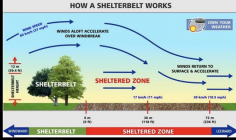DON'T QUOTE ME, THIS IS PLAGERISED. It just takes a little research on the Internet and evaluation of your particular environment to consider yet another external ballistics factor. Then add "eye of newt and toe of frog, wool of bat, tongue of dog, adder's fork and blind-worm's sting, lizard's leg and owlet's wing, ..."
I suggest you may want to also look up the subjects of maximum ordinate and ground roughness.
Wind Breaks/Shelterbelts
Buildings, forests, and windbreaks (shrubberies or trees) reduce near-surface wind speed, having the most impact when the wind blows perpendicular to them. Many shooting ranges have tree-lines and/or berms on both sides, constructed primarily as a safety precaution, that also impact the flow of air. Trees lining the right-side of the range are a blocking force and the wind comes tumbling back. Shooters on the far-left can read a steady wind where the shooters on right have flags switching constantly.
For dense shelterbelts with little through-flow, winds are reduced greatly near the windbreak, but
wind speed fully recovers downwind about 15 times the height of the trees. More open shelter belts, e.g., thick shrubbery and single tree rows, allow more through-flow so wind speed is reduced less near the trees, but
wind speed fully recovers downwind about 30 times the height of the impediment. Wind speed in both cases also is
reduced upwind for a distance equal to
3 to 4 times the height of the impediment.
View attachment 1567302












